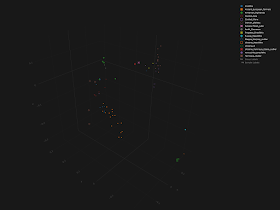Monday, February 13, 2023
Dear David, Nick, Iosif...let me tell you about Yamnaya
Lazaridis, Alpaslan-Roodenberg et al. recently claimed that the Yamnaya people of the Pontic-Caspian (PC) steppe carried "substantial" ancestry from what is now Armenia or surrounds.
However, this claim is essentially false.
Only one individual associated with the Yamnaya culture shows an unambiguous signal of such ancestry. This is a female usually labeled Ukraine_Yamnaya_Ozera_o:I1917. The "o" suffix indicates that she is an outlier from the main Yamnaya genetic cluster.
Unlike I1917, typical Yamnaya individuals carry a few per cent of ancient European farmer admixture. This ancestry is only very distantly Armenian-related via Neolithic Anatolia (see here).
It's difficult for me to understand how Lazaridis, Alpaslan-Roodenberg et al. missed this. I suspect that they relied too heavily on formal statistics and overinterpreted their results.
Formal statistics are a very useful tool in ancient DNA work. Unfortunately, they're also a relatively blunt tool that often has problems distinguishing between similar sources of gene flow.
There are arguably better methods for studying fine scale ancestry, such as Principal Component Analysis (PCA).
Below is a somewhat special PCA featuring a wide range of ancient populations that plausibly might be relevant to the genetic origins of the Yamnaya people. Unlike most PCA with ancient samples, this PCA doesn't rely on any sort of projection, so that all of the actors are interacting with each other and directly affecting the outcome.
Here's another version of the same plot with a less complicated labeling system. Note that I designed this PCA specifically to differentiate between European populations and those from the Armenian highlands, the Iranian plateau and surrounds.
And here's a close up of the part of the plot that shows the Yamnaya cluster. This cluster is made up of samples associated with the Afanasievo, Catacomb, Poltavka and Yamnaya cultures. All of the individuals in this part of the plot are closely related, which is why they're so tightly packed together. The differentiation between them is caused by admixture from different groups mostly from outside of the PC steppe.
The Yamnaya cluster can be broadly characterized as a population that formed along the genetic continuum between the Eneolithic groups of the Progress region and Neolithic foragers from the Dnieper River valley (Progress_Eneolithic and Ukraine_N, respectively). However, this cluster also shows a slight western shift that is increasingly more pronounced in the Corded Ware samples. This shift is due to the aforementioned admixture from early European farmers.
Indeed, the plot reveals two parallel clines extending west from the Progress samples. One of the clines is made up of the Yamnaya cluster and the Corded Ware samples, and pulls towards the ancient European farmers. The other cline includes Ukraine_Yamnaya_Ozera_o:I1917 and pulls towards samples from the Armenian highlands and surrounds.
Being aware of these two clines and knowing how they came about is important to understanding the genetic prehistory of the PC steppe and indeed of much of Eurasia.
At some point, probably during the late Eneolithic, a Progress-related group experienced gene flow from the west and became the Yamnaya and Corded Ware populations. Sporadically, admixture from the Armenian highlands and the Iranian plateau also entered the PC steppe, giving rise to people like the Steppe Maykop outliers and Ukraine_Yamnaya_Ozera_o:I1917.
Unfortunately, this sort of PCA doesn't offer output suitable for mixture modeling, basically because the recent genetic drift shared by many of the samples creates significant noise.
However, to check that my inferences based on the plot are correct I can create composites with specific ancestry proportions to see how they behave. In the plot below Mix1 is 80% Progress_Eneolithic and 20% Iran_Hajji_Firuz_N, Mix2 is 80% Progress_Eneolithic and 20% Armenia_EBA_Kura_Araxes, while Mix3 is 80% Progress_Eneolithic, 15% Ukraine_N and 5% Hungary_MN_Vinca (Middle Neolithic farmers from the Carpathian Basin).
Obviously, we can't get Yamnaya by mixing Progress_Eneolithic with any ancients from the Armenian highlands or the Iranian plateau. On the other hand, Mix3 works quite well, at least in the first two dimensions. In some of the other dimensions genetic drift specific to Ukraine_N pulls it away from the Yamnaya cluster, but this is to be expected.
By the way, the plots were created with the excellent Vahaduo Custom PCA tool freely available here. It's well worth trying the interactive 3D option using my PCA data. The relevant datasheet is available here.
See also...
Dear David, Nick, Iosif...let's set the record straight
The Caucasus is a semipermeable barrier to gene flow




